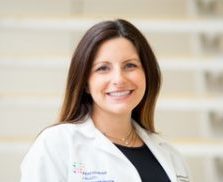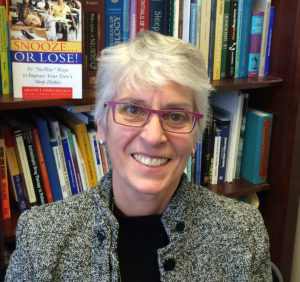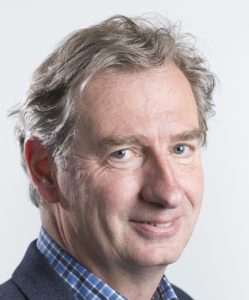touchEXPERT OPINIONS Management of excessive daytime sleepiness in patients with obstructive sleep apnea or narcolepsy: A common link for separate conditions
Leading sleep medicine experts explore strategies for the optimal management of excessive daytime sleepiness associated with obstructive sleep apnea or narcolepsy.
Dr Annamaria Iakovou outlines the importance of recognizing EDS in people who are living with OSA or narcolepsy, and provides practical guidance on how to meaningfully evaluate and determine the primary underlying cause.
1/3 Next InterviewIn this interview Dr Annamaria Iakovou answers the following questions:
- Why is it important to recognize EDS, and how does it impact people living with OSA or narcolepsy?
- What assessments are needed to meaningfully evaluate EDS?
- How can we overcome the challenges associated with diagnosing the underlying cause of EDS?
- How do EDS assessments help to guide medical management strategies for people with OSA or narcolepsy?
Annamaria Iakovou, MD, is an Associate Professor of Medicine at the Donald and Barbara Zucker School of Medicine at Hofstra/Northwell in New York, NY, USA. She completed her Internal Medicine Residency and Chief Residency at Mount Sinai St. Luke’s-Roosevelt Hospital. She continued to receive a fellowship in Pulmonary and Critical Care Medicine at Northwell Health (formerly North Shore-Long Island Jewish Health System) as well as a Sleep Medicine fellowship. read more
Her interests include medical education, and she holds the position of Associate Program Director for the Pulmonary and Critical Care Medicine fellowship. She is also interested in quality improvement and is involved in an ongoing project at North Shore University Hospital as the physician lead in the 30-day readmission reduction initiative for pneumonia and chronic obstructive pulmonary disease. More recently, she has been involved in launching the ‘Northwell Apnea Program: A Cardiovascular and Sleep Collaboration’ that was created to screen patients with cardiovascular comorbidities and provide home sleep apnea testing to diagnose and manage sleep-disordered breathing.
Dr Annamaria Iakovou has no interests/relationships or affiliations to disclose in relation to this activity.
Prof. Helene A Emsellem outlines current treatment approaches and explores how the management of EDS may be optimized for people living with OSA or narcolepsy.
2/3 Next InterviewIn this interview Prof. Helene A Emsellem answers the following questions:
- Why is it important to manage EDS in people living with OSA or narcolepsy?
- What role do non-pharmacological measures currently play in the management of EDS?
- How and when should pharmacotherapies be deployed in the management of EDS?
- What more is needed to optimize quality of life and address ongoing unmet needs for people living with EDS?
Helene A Emsellem, MD, is the Director of The Center of Sleep & Wake Disorders in Chevy Chase, MD, USA, and is a Clinical Professor of Neurology at George Washington University, Washington, DC, USA. She is interested in all aspects of sleep disorders, including their diagnosis and treatment, the study of new agents, devices to manage sleep disorders and public education. Prof. Emsellem has been active with the National Sleep Foundation promoting sleep health to the public, and has served as the Chairman of the Board of Directors for the National Sleep Foundation from 2018 to 2019. She chaired the 2014 Sleep in America Poll Taskforce examining Sleep in the Modern Family, and is a frequently quoted media resource. read more
Prof. Emsellem is the author of the book, Snooze… or Lose! Ten No-War Ways to Improve Your Teen’s Sleep Habits, a book written to help teens understand the importance of sleep, and to empower them to own and improve their sleep–wake habits and schedules. Additionally, she is coauthor of Neuro-Logic: A Primer on Localization, a foundational text about localization in the nervous system — the fundamental skill of clinical neurology. She is committed to the advancement of sleep medicine and is actively involved in clinical research in many areas of sleep medicine, including narcolepsy, restless leg syndrome, obstructive sleep apnea, circadian rhythm sleep disorders, and sleep onset and maintenance insomnia.
Prof. Helene A Emsellem discloses Advisory board or panel fees from Harmony Biosciences, Jazz Pharmaceuticals and Takeda. Consultant fees from Respironics and Vanda Pharmaceuticals. Grants/research support from Apnimed, Avadel Pharmaceuticals, Axsome Therapeutics, Harmony Biosciences, Idorsia, Imbrium Therapeutics, Jazz Pharmaceuticals, Merck, Respironics, Suven Life Sciences and Takeda. Speaker’s bureau fees from Jazz Pharmaceuticals.
Prof. Gert Jan Lammers explores the emerging treatment landscape, appraising the latest clinical evidence for new and emerging agents, and contextualizing the potential implications for the future management of EDS.
3/3 Take CE/CME TestIn this interview Prof. Gert Jan Lammers answers the following questions:
- How might new and emerging agents impact future approaches to the management of EDS in people living with OSA or narcolepsy?
- How are new and emerging agents targeting our current understanding of the pathophysiology of EDS?
- What are we learning from clinical trial data about the efficacy of these new and emerging agents in the management of EDS?
- What safety aspects should we consider when evaluating the use of these agents to manage EDS in people living with OSA and narcolepsy?
Prof. Gert Jan Lammers is a Professor in Sleep Medicine and medical director of the Sleep-Wake Expertise Centres of SEIN, and a practising neurologist at Leiden University Medical Centre Leiden, the Netherlands. He has long standing experience in clinical care for sleep patients and research. His research focuses on hypersomnolence, the phenotyping of the various disorders of hypersomnolence, the role of hypocretin/orexin (deficiency), and also the non-pharmacological and pharmacological treatment.
Prof. Gert Jan Lammers discloses Consultancy fees from Jazz Pharmaceuticals. Grants/research support from Bioprojet, Jazz Pharmaceuticals and UCB.
Overview & Learning Objectives
Overview
In this activity, leading sleep medicine physicians explore strategies for the optimal management of excessive daytime sleepiness (EDS) associated with obstructive sleep apnea (OSA) or narcolepsy and share insights and potential implications for clinical practice.
This activity is jointly provided by USF Health and touchIME. read more
Target Audience
This activity has been designed to meet the educational needs of neurology and respiratory physicians, including sleep specialists, neurologists and psychiatrists, as well as primary care physicians involved in the management of excessive daytime sleepiness.
Disclosures
USF Health adheres to the Standards for Integrity and Independence in Accredited Continuing Education. All individuals in a position to influence content have disclosed to USF Health any financial relationship with an ineligible organization. USF Health has reviewed and mitigated all relevant financial relationships related to the content of the activity. The relevant relationships are listed below. All individuals not listed have no relevant financial relationships.
Faculty
Dr Annamaria Iakovou has no interests/relationships or affiliations to disclose in relation to this activity.
Prof. Helene A Emsellem discloses Advisory board or panel fees from Harmony Biosciences, Jazz Pharmaceuticals and Takeda. Consultant fees from Respironics and Vanda Pharmaceuticals. Grants/research support from Apnimed, Avadel Pharmaceuticals, Axsome Therapeutics, Harmony Biosciences, Idorsia, Imbrium Therapeutics, Jazz Pharmaceuticals, Merck, Respironics, Suven Life Sciences and Takeda. Speaker’s bureau fees from Jazz Pharmaceuticals.
Prof. Gert Jan Lammers discloses Consultancy fees from Jazz Pharmaceuticals. Grants/research support from Bioprojet, Jazz Pharmaceuticals and UCB.
Content reviewer
Karim H Hanna, MD has no financial interests/relationships or affiliations in relation to this activity.
Touch Medical Director
Christina Mackins-Crabtree, PhD, CMPP has no financial interests/relationships or affiliations in relation to this activity.
USF Health Office of Continuing Professional Development and touchIME staff have no financial interests/relationships or affiliations in relation to this activity.
Requirements for Successful Completion
In order to receive credit for this activity, participants must review the content and complete the post-test and evaluation form. Statements of credit are awarded upon successful completion of the post-test and evaluation form.
If you have questions regarding credit please contact cpdsupport@usf.edu
Accreditations
Physicians
This activity has been planned and implemented in accordance with the accreditation requirements and policies of the Accreditation Council for Continuing Medical Education (ACCME) through a joint providership of USF Health and touchIME. USF Health is accredited by the ACCME to provide continuing medical education for physicians.
USF Health designates this enduring material for a maximum of 0.75 AMA PRA Category 1 CreditTM. Physicians should claim only the credit commensurate with the extent of their participation in the activity.
The European Union of Medical Specialists (UEMS) – European Accreditation Council for Continuing Medical Education (EACCME) has an agreement of mutual recognition of continuing medical education (CME) credit with the American Medical Association (AMA). European physicians interested in converting AMA PRA Category 1 CreditTM into European CME credit (ECMEC) should contact the UEMS (www.uems.eu).
Advanced Practice Providers
Physician Assistants may claim a maximum of 0.75 Category 1 credits for completing this activity. NCCPA accepts AMA PRA Category 1 CreditTM from organizations accredited by ACCME or a recognized state medical society.
The AANPCP accepts certificates of participation for educational activities approved for AMA PRA Category 1 CreditTM by ACCME-accredited providers. APRNs who participate will receive a certificate of completion commensurate with the extent of their participation.
Date of original release: 02 December 2021. Date credits expire: 02 December 2023.
If you have any questions regarding credit please contact cpdsupport@usf.edu
Learning Objectives
After watching this activity, participants should be better able to:
- Distinguish EDS from fatigue/tiredness, improving the ability to differentially diagnose OSA and narcolepsy
- Apply non-pharmacological and pharmacological management strategies for EDS in OSA or narcolepsy
- Interpret key efficacy and safety data on emerging therapies for the management of EDS in OSA and narcolepsy

Register to touchRESPIRATORY for FREE
- Peer-reviewed journals and expert opinions
- Interactive CME and e-learning modules
- Video conference highlights



